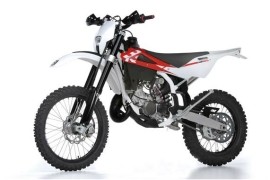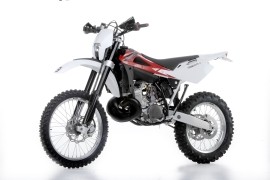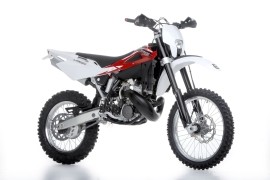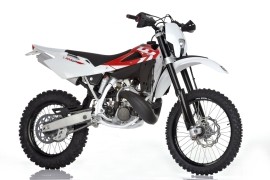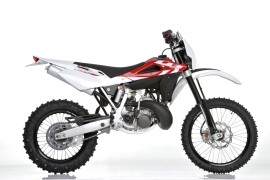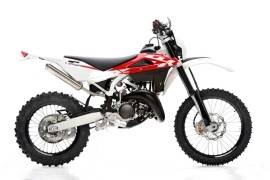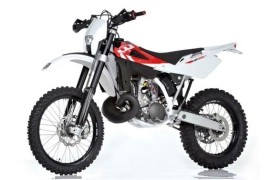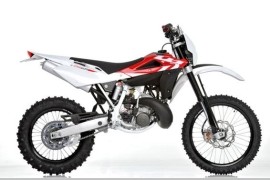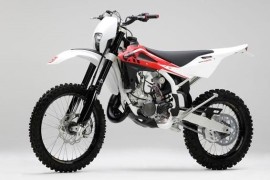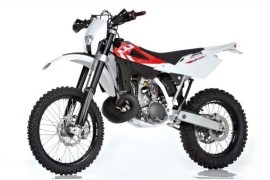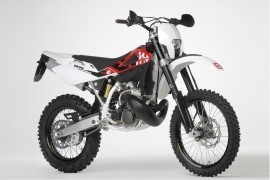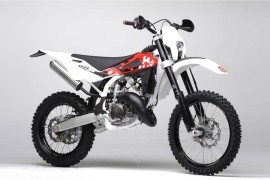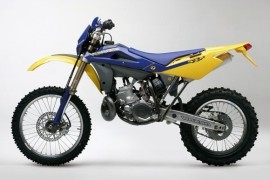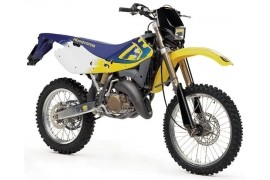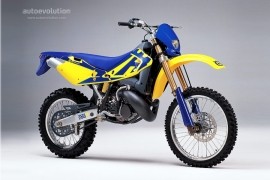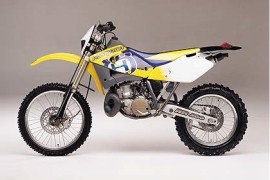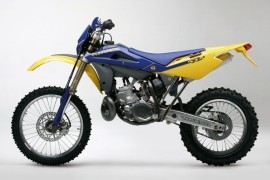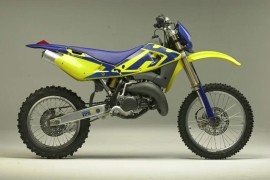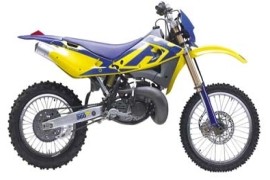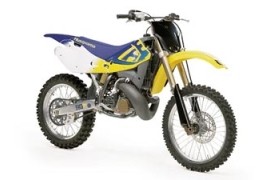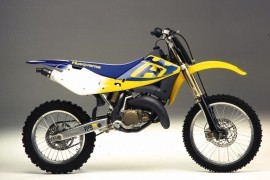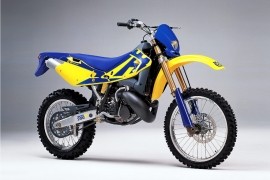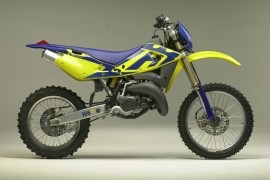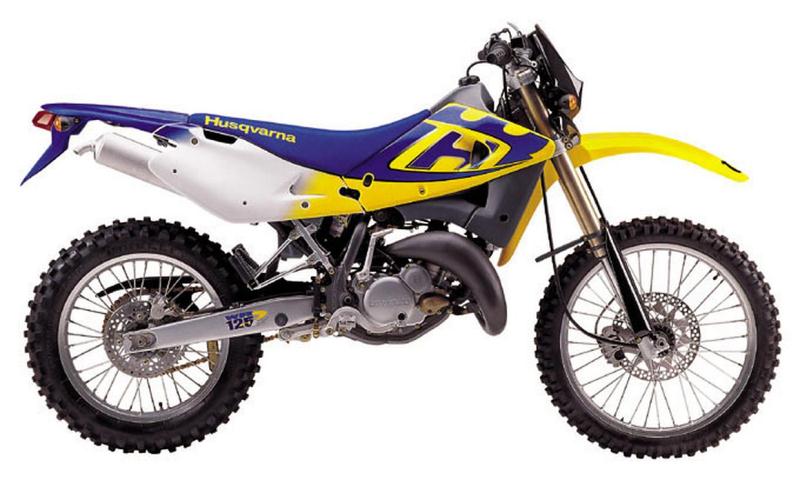HUSQVARNA WR Models/Series Timeline, Specifications & Photos
First production year: 1995
In 2011, the Swedish motorcycle maker released the Husqvarna WR 125, a lightweight, powerful, and maneuverable machine designed for young riders who wanted to start in Enduro.
Husqvarna was a Swedish manufacturer of outdoor power products, such as lawnmowers, chainsaws, trimmers, brush cutters, cultivators, garden tractors, and, why not, motorcycles. The company was founded in 1689 as a firearm manufacturer and was one of the oldest continuously running companies in the world.
The Husqvarna WR 125 was a motorcycle based on the Husqvarna CR model, prepared for the European enduro, which packed a 125cc two-stroke engine. The bike was often confused with the Husqvarna WRE, produced in 125cc only.
The 2011 model featured technical modifications derived from Husqvarna's experience in the European Motocross and Enduro Championships, such as a new chassis, a new graphic design, a number protection system on the headlight, and new hand guards.
In addition, the engine department received a new clutch housing, a new muffler, and a thermostat that monitored and optimized engine running temperature. The instrument cluster featured a new digital display instead of the earlier analog one.
Regarding power, the 2011 Husqvarna WR 125 had installed a 124cc two-stroke liquid-cooled single-cylinder engine at its core. It was fed by a 38 mm Mikuni TMX carburetor and paired with a six-speed manual transmission with a final chain drive.
Husqvarna was a Swedish manufacturer of outdoor power products, such as lawnmowers, chainsaws, trimmers, brush cutters, cultivators, garden tractors, and, why not, motorcycles. The company was founded in 1689 as a firearm manufacturer and was one of the oldest continuously running companies in the world.
In 2011, the Swedish motorcycle manufacturer released the Husqvarna WR 250, a quarter-liter off-road motorcycle with the same shape and form as the previous one without any modifications. At the time, the bike was for sale at an MSRP of $6,800.
The bike was made around a single-tube cradle steel frame and alloy rear frame, which housed the suspension system, which consisted of an inverted Marzocchi adjustable fork on the front and an adjustable Sachs shock on the rear.
The 21-inch front wheel was fitted with a 260 mm brake disc, while a 220 mm rotor was mounted on the rear wheel. Both discs were clamped by hydraulic calipers, providing optimum braking performance.
The 2011 Husqvarna WR 250 had installed a 249cc two-stroke liquid-cooled single-cylinder engine underneath its fuel tank. It was managed by a 38 mm Mikuni TMX carburetor and assisted by a six-speed gearbox with a final chain drive.
The visual department remained unchanged, packing the same standard features, such as white and red plastics, a high-mounted front mudguard, a single seat, a small headlight integrated into a small cowl, hand guards, and wire-spoke wheels with off-road tires.
Husqvarna was a Swedish manufacturer of outdoor power products, such as lawnmowers, chainsaws, trimmers, brush cutters, cultivators, garden tractors, and, why not, motorcycles. The company was founded in 1689 as a firearm manufacturer and was one of the oldest continuously running companies in the world.
In 2011, the Swedish motorcycle maker released the Husqvarna WR 300, an off-road motorcycle in its third production year. It was a transformation kit of the smaller WR 250 model and a perfect replica of the bike raced by Seb Guillaume in Class Three of the Enduro World Championship series.
The 2011 model year was delivered in the same shape and form as the previous model, packing the same visual, performance, and technical characteristics without any modifications whatsoever.
The bike rolled on a 21-inch front wheel softened by an inverted adjustable Marzocchi fork and stopped by a 260 mm brake disc with a hydraulic caliper. The rear was controlled by an 18-inch wheel with an adjustable Sachs shock and a 220 mm brake rotor clamped by a hydraulic caliper.
In the performance department, the 2011 Husqvarna WR 300's heartbeat was set by a 293cc two-stroke liquid-cooled single-cylinder engine with a 38 mm Mikuni carburetor in charge and a five-speed gearbox with a chain drive.
In the visual department, the bike had standard fittings, like wire-spoke wheels with black anodized rims and off-road tires, a single seat, a small cowl with a tiny headlight, and a single exhaust system with a high-mounted silencer on the right-hand-side.
In 2010, the Swedish motorcycle maker released the Husqvarna WR 300, an off-road motorcycle in its second production year. It was a transformation kit of the smaller WR 250 model and a perfect replica of the motorcycle raced by Seb Guillaume in Class Three of the Enduro World Championship series.
The 2010 was delivered in the same shape and form as the previous model, packing the same visual, performance, and technical characteristics without any modifications whatsoever.
Husqvarna was a Swedish manufacturer of outdoor power products, such as lawnmowers, chainsaws, trimmers, brush cutters, cultivators, garden tractors, and, why not, motorcycles. The company was founded in 1689 as a firearm manufacturer and was one of the oldest continuously running companies in the world.
Aesthetically, the motorcycle was similar to the smaller version, packing standard features like wire-spoke wheels with black anodized rims and off-road tires, a single seat, a small cowl with a tiny headlight, and a single exhaust system with a high-mounted silencer on the right-hand-side.
The bike rolled on a 21-inch front wheel softened by an inverted adjustable Marzocchi fork and stopped by a 260 mm brake disc with a hydraulic caliper. The rear was controlled by an 18-inch wheel with an adjustable Sachs shock and a 220 mm brake rotor clamped by a hydraulic caliper.
Power-wise, the 2010 Husqvarna WR 300's heartbeat was set by a 293cc two-stroke liquid-cooled single-cylinder engine with a 38 mm Mikuni carburetor in charge and a five-speed gearbox with a chain drive.
In 2010, with no further modifications, the Swedish motorcycle maker released the Husqvarna WR 250, an off-road quarter-liter enduro machine created for those riders who wanted the unmistakable sound and feel of a two-stroke engine. At the time, the bike was sold at an MSRP of $6,800.
Husqvarna was a Swedish manufacturer of outdoor power products, such as lawnmowers, chainsaws, trimmers, brush cutters, cultivators, garden tractors, and, why not, motorcycles. The company was founded in 1689 as a firearm manufacturer and was one of the oldest continuously running companies in the world.
Visually, the motorcycle had standard fittings like white and red plastics, a high-mounted front mudguard, a single seat, a small headlight integrated into a small cowl, hand guards, and wire-spoke wheels with off-road tires.
In the performance department, the 2010 Husqvarna WR 250's soul was brought to life by a 249cc two-stroke liquid-cooled single-cylinder engine mounted underneath its fuel tank. It was fed by a 38 mm Mikuni TMX carburetor and assisted by a six-speed gearbox.
The bike was made around a single-tube cradle steel frame and alloy rear frame, which housed the suspension system, which consisted of an inverted Marzocchi adjustable fork on the front and an adjustable Sachs shock on the rear.
The 21-inch front wheel was fitted with a 260 mm brake disc, while a 220 mm rotor was mounted on the rear wheel. Both discs were clamped by hydraulic calipers, providing optimum braking performance.
In 2010, the Swedish motorcycle maker released the Husqvarna WR 125, an entry-level off-road motorcycle designed for the youngest and less experienced riders but also suitable for the more experienced ones looking for a fun, light, and agile machine.
Husqvarna was a Swedish manufacturer of outdoor power products, such as lawnmowers, chainsaws, trimmers, brush cutters, cultivators, garden tractors, and, why not, motorcycles. The company was founded in 1689 as a firearm manufacturer and was one of the oldest continuously running companies in the world.
The Husqvarna WR 125 was a motorcycle based on the Husqvarna CR model, prepared for the European enduro, which packed a 125cc two-stroke engine. The bike was often confused with the Husqvarna WRE, produced in 125cc only.
The bike was built around a steel frame with an alloy rear subframe. It housed the suspension system, which comprised an inverted adjustable Marzocchi fork on the front and an adjustable Sachs shock on the rear.
Visually, the motorcycle had standard fittings, such as a tiny headlight integrated into a small cowl, a high-mounted front fender, hand guards, a single seat, a single exhaust system, a dual-sided swingarm, and wire-spoke wheels with off-road tires.
As for power, the 2010 Husqvarna WR 125 had installed a 124cc two-stroke single-cylinder liquid-cooled engine under the fuel tank, fed by a 41 mm Mikuni carburetor and assisted by a six-speed transmission.
In 2009, the Swedish motorcycle manufacturer introduced the Husqvarna WR 300, a transformation kit of the smaller WR 250 model and a perfect replica of the motorcycle raced by Seb Guillaume in Class Three of the Enduro World Championship series.
Husqvarna was a Swedish manufacturer of outdoor power products, such as lawnmowers, chainsaws, trimmers, brush cutters, cultivators, garden tractors, and, why not, motorcycles. The company was founded in 1689 as a firearm manufacturer and was one of the oldest continuously running companies in the world.
Its displacement increased from 250 to 300cc, and almost all components were new, offering more aggressive power through the rev range. Compared to the WR 250, the WR 300 featured changes to the cylinder head and exhaust pipe, a new V-Force reed valve system, a larger Mikuni carburetor, and a new exhaust valve.
Visually, the bike was similar to its predecessor, packing standard features like wire-spoke wheels with black anodized rims and off-road tires, a single seat, a small cowl with a tiny headlight, and a single exhaust system with a high-mounted silencer on the right-hand-side.
In addition to its engine modifications, the WR 300 motorcycle also received new Brembo disc brakes, a newly calibrated Marzocchi inverted fork on the front, a new Sachs shock absorber, a new headlight, and a compact digital display.
The 2009 Husqvarna WR 300's power came from a 293cc two-stroke single-cylinder liquid-cooled engine fed by a 38 mm Mikuni TMX carburetor. The engine was paired with a five-speed gearbox that sent the power to the rear via a final chain drive.
In 2009, the Swedish motorcycle maker released the Husqvarna WR 250, a quarter-liter off-road motorcycle similar to the previous one, featuring the same technical, performance, and visual characteristics without any changes.
Until 2006, the bike received only minor modifications as the maker planned a major revamp for the 2007 model year. The 2007 WR 250 had a new seat, a new fuel tank, and panels with a white and red color scheme. In addition, the model came with new instruments and a redesigned handlebar.
Husqvarna was a Swedish manufacturer of outdoor power products, such as lawnmowers, chainsaws, trimmers, brush cutters, cultivators, garden tractors, and, why not, motorcycles. The company was founded in 1689 as a firearm manufacturer and was one of the oldest continuously running companies in the world.
The 2009 model remained largely unchanged from the 2007 model year, packing features such as white and red plastics, a high-mounted front mudguard, a single seat, a small headlight integrated into a small cowl, hand guards, and wire-spoke wheels with off-road tires.
The bike was made around a single-tube cradle steel frame and alloy rear frame, which housed the suspension system, which consisted of an inverted Marzocchi adjustable fork on the front and an adjustable Sachs shock on the rear.
The 2009 Husqvarna WR 250 was powered by a 249cc two-stroke liquid-cooled single-cylinder engine, managed by a 38 mm Mikuni TMX carburetor, and a six-speed transmission sent the power to the rear via a final chain drive.
In 2009, the Swedish motorcycle maker released the Husqvarna WR 125, an off-road entry-level motorcycle created for younger and less experienced riders as well as for more experienced ones looking for a fun, agile, and light machine.
Husqvarna was a Swedish manufacturer of outdoor power products, such as lawnmowers, chainsaws, trimmers, brush cutters, cultivators, garden tractors, and, why not, motorcycles. The company was founded in 1689 as a firearm manufacturer and was one of the oldest continuously running companies in the world.
The Husqvarna WR 125 was a motorcycle based on the Husqvarna CR model, prepared for the European enduro, which packed a 125cc two-stroke engine. The bike was often confused with the Husqvarna WRE, produced in 125cc only.
Visually, the motorcycle had standard fittings, such as a tiny headlight integrated into a small cowl, a high-mounted front fender, hand guards, a single seat, a single exhaust system, a dual-sided swingarm, and wire-spoke wheels with off-road tires.
The motorcycle was made around a steel frame with a 45 mm adjustable Marzocchi fork on the front and an adjustable Sachs shock on the rear, providing optimum suspension performance and handling.
As for power, the 2009 Husqvarna WR 125 had installed a 124cc two-stroke single-cylinder liquid-cooled engine under the fuel tank, fed by a 41 mm Mikuni carburetor and assisted by a six-speed transmission.
Husqvarna was a Swedish manufacturer of outdoor power products, such as lawnmowers, chainsaws, trimmers, brush cutters, cultivators, garden tractors, and, why not, motorcycles. The company was founded in 1689 as a firearm manufacturer and was one of the oldest continuously running companies in the world.
In 2009, the Swedish motorcycle manufacturer introduced the Husqvarna WR 300, a transformation kit of the smaller WR 250 model and a perfect replica of the motorcycle raced by Seb Guillaume in Class Three of the Enduro World Championship series.
Its displacement increased from 250 to 300cc, and almost all components were new, offering more aggressive power through the rev range. Compared to the WR 250, the WR 300 featured changes to the cylinder head and exhaust pipe, a new V-Force reed valve system, a larger Mikuni carburetor, and a new exhaust valve.
In addition to its engine modifications, the WR 300 motorcycle also received new Brembo disc brakes, a newly calibrated Marzocchi inverted fork on the front, a new Sachs shock absorber, a new headlight, and a compact digital display.
Visually, the bike was similar to its predecessor, packing standard features like wire-spoke wheels with black anodized rims and off-road tires, a single seat, a small cowl with a tiny headlight, and a single exhaust system with a high-mounted silencer on the right-hand-side.
The 2009 Husqvarna WR 300's power came from a 293cc two-stroke single-cylinder liquid-cooled engine fed by a 38 mm Mikuni TMX carburetor. The engine was paired with a five-speed gearbox that sent the power to the rear via a final chain drive.
Husqvarna was a Swedish manufacturer of outdoor power products, such as lawnmowers, chainsaws, trimmers, brush cutters, cultivators, garden tractors, and, why not, motorcycles. The company was founded in 1689 as a firearm manufacturer and was one of the oldest continuously running companies in the world.
In 2008, the Swedish motorcycle manufacturer released the Husqvarna WR 250, an off-road motorcycle and a member of the WR series. The bike was visually different from earlier models and was sold with an MSRP of $6,300.
The visual department was characterized by features such as white and red plastics, a high-mounted front mudguard, a single seat, a small headlight integrated into a small cowl, hand guards, and wire-spoke wheels with off-road tires.
The bike's single tube cradle steel frame and alloy rear frame housed the suspension system, which was composed of an inverted Marzocchi adjustable fork on the front and an adjustable Sachs shock on the rear. This system provided excellent suspension performance and handling capabilities.
The braking performance was achieved by a 260 mm brake disc mounted on the 21-inch front wheel and a 220 mm brake rotor mounted on the 18-inch rear wheel, offering excellent stopping power.
As for power, the 2008 Husqvarna WR 250 had installed a 249cc two-stroke liquid-cooled single-cylinder engine at its core. The engine was managed by a 38 mm Mikuni TMX carburetor, and a six-speed transmission sent the power to the rear via a final chain drive.
Husqvarna was a Swedish manufacturer of outdoor power products, such as lawnmowers, chainsaws, trimmers, brush cutters, cultivators, garden tractors, and, why not, motorcycles. The company was founded in 1689 as a firearm manufacturer and was one of the oldest continuously running companies in the world.
The Husqvarna WR 125 was a motorcycle based on the Husqvarna CR model, prepared for the European enduro, which packed a 125cc two-stroke engine. The bike was often confused with the Husqvarna WRE, produced in 125cc only.
In 2008, the Swedish motorcycle maker, which was, by the way, bought by BMW, released the Husqvarna WR 125, a small displacement motorcycle created for less experienced riders that came with several visual and technical modifications.
The 2008 model came with new features, such as the frame, fuel tank, bodywork, seat, air filter box, aluminum subframe, side stand, and redesigned foot pegs and swingarm.
The 2008 Husqvarna WR 125 had installed a 124cc two-stroke liquid-cooled single-cylinder engine at its core. The engine was managed by a 38 mm Mikuni TMX carburetor and paired to a six-speed manual gearbox with a final chain drive.
The motorcycle's aesthetic department was characterized by standard features, such as a tiny headlight integrated into a small cowl, a high-mounted front fender, hand guards, a single seat, a single exhaust system, a dual-sided swingarm, and wire-spoke wheels with off-road tires.
Husqvarna was a Swedish manufacturer of outdoor power products, such as lawnmowers, chainsaws, trimmers, brush cutters, cultivators, garden tractors, and, why not, motorcycles. The company was founded in 1689 as a firearm manufacturer and was one of the oldest continuously running companies in the world.
In 2003, the Swedish motorcycle maker released the Husqvarna WR 250, an off-road motorcycle in the WR series, which comprised several motorcycles with different engine displacements and similar appearances.
The 2003 model was delivered in the same shape and form as the previous ones, featuring the same visual, performance, and technical characteristics without any changes whatsoever.
The 2003 Husqvarna WR 250 was powered by a 249cc two-stroke liquid-cooled single-cylinder engine, fed by a 38 mm Mikuni carburetor and assisted by a six-speed transmission linked to the rear end via a final chain drive.
The motorcycle was built around a steel frame that housed the suspension system, which comprised an adjustable 45 mm inverted Marzocchi fork on the front and an adjustable shock on the rear. These components offered optimum suspension performance and handling capabilities.
In the braking department, the motorcycle had a 260 mm brake disc on the 21-inch front wheel and a 220 mm brake disc on the 18-inch rear wheel. Both wheels were handled by hydraulic calipers.
The bike's aesthetic features included standard features such as wire-spoke wheels with off-road tires, a single exhaust system with a silencer mounted high on the right-hand side, a single seat, a small headlight integrated into a small cowl, and a high-mounted front mudguard.
Husqvarna was a Swedish manufacturer of outdoor power products, such as lawnmowers, chainsaws, trimmers, brush cutters, cultivators, garden tractors, and, why not, motorcycles. The company was founded in 1689 as a firearm manufacturer and was one of the oldest continuously running companies in the world.
The Husqvarna WR 125 was a motorcycle based on the Husqvarna CR model, prepared for the European enduro, which packed a 125cc two-stroke engine. The bike was often confused with the Husqvarna WRE, produced in 125cc only.
In 2003, Husqvarna released the Husqvarna WR 125, a small displacement, off-road machine designed for younger and less experienced fans of the brand and for more experienced ones. It came in the same shape and form as previous ones without any modifications.
The motorcycle was made around a steel frame with a 45 mm adjustable Marzocchi fork on the front and an adjustable Sachs shock on the rear, providing optimum suspension performance and handling.
It rolled on a 21-inch front wheel fitted with a 260 mm brake disc and an 18-inch rear wheel with a 220 mm brake disc. Both discs were clamped by hydraulic calipers, providing optimum stopping power.
As for power, the 2003 Husqvarna WR 125's heartbeat was set by a 124cc two-stroke single-cylinder liquid-cooled engine, fed by a 41 mm Mikuni carburetor and assisted by a six-speed transmission.
In 2002, the Swedish motorcycle manufacturer Husqvarna released the WR 250, a quarter-liter off-road motorcycle addressed to young riders as well as the more seasoned ones. It came in the same shape and form as the previous model without any modifications whatsoever.
Husqvarna was a Swedish manufacturer of outdoor power products, such as lawnmowers, chainsaws, trimmers, brush cutters, cultivators, garden tractors, and, why not, motorcycles. The company was founded in 1689 as a firearm manufacturer and was one of the oldest continuously running companies in the world.
The motorcycle was built around a steel frame that housed the suspension system, which comprised an adjustable 45 mm inverted Marzocchi fork on the front and an adjustable shock on the rear. These components offered optimum suspension performance and handling capabilities.
In the braking department, the motorcycle had a 260 mm brake disc on the 21-inch front wheel and a 220 mm brake disc on the 18-inch rear wheel. Both wheels were handled by hydraulic calipers.
Visually, the 2002 machine had standard fittings, like a high-mounted front mudguard, a small headlight integrated into a small cowl, a single seat, a single exhaust system with a silencer mounted high on the right-hand side, and wire-spoke wheels with off-road tires.
As for power, the 2002 Husqvarna WR 250 packed a 249cc two-stroke liquid-cooled single-cylinder engine, fed by a 38 mm Mikuni carburetor and assisted by a six-speed transmission linked to the rear end via a final chain drive.
In 2002, the Swedish motorcycle maker released the Husqvarna WR 125, one of the lightest and most agile motorcycles in its class, tipping the scale at only 92 kg (203 lbs). It was created for the youngest, less experienced riders and suitable for the more experienced ones.
Husqvarna was a Swedish manufacturer of outdoor power products, such as lawnmowers, chainsaws, trimmers, brush cutters, cultivators, garden tractors, and, why not, motorcycles. The company was founded in 1689 as a firearm manufacturer and was one of the oldest continuously running companies in the world.
The Husqvarna WR 125 was a motorcycle based on the Husqvarna CR model, prepared for the European enduro, which packed a 125cc two-stroke engine. The bike was often confused with the Husqvarna WRE, produced in 125cc only.
Performance-wise, the 2002 Husqvarna WR 125 had installed a 124cc single-cylinder liquid-cooled two-stroke engine at its core. It was managed by a 41 mm Mikuni carburetor and assisted by a six-speed gearbox with a final chain drive.
The bike's steel frame housed the suspension system, which comprised a 45 mm Marzocchi upside-down adjustable fork on the front and an adjustable Sachs shock on the rear, providing optimum handling capabilities.
As for the visual appearance, the motorcycle packed a small square headlight integrated into a tiny cowl, a high-mounted front mudguard, a single seat, a single exhaust system with a muffler mounted high on the right-hand side, and wire-spoke wheels with off-road tires.
Husqvarna was a Swedish manufacturer of outdoor power products, such as lawnmowers, chainsaws, trimmers, brush cutters, cultivators, garden tractors, and, why not, motorcycles. The company was founded in 1689 as a firearm manufacturer and was one of the oldest continuously running companies in the world.
In 2001, the Swedish motorcycle maker released the Husqvarna WR 360, one of the most powerful two-stroke dirt motorcycles ever designed by Husqvarna. It was in its fourth and last production year and packed the same characteristics as the previous ones without any changes.
The bike was built around a steel tube cradle frame with an alloy subframe. It housed the suspension system, which comprised an adjustable Marzocchi inverted fork on the front and an adjustable Sachs shock on the rear.
The braking performance was handled by a 260 mm brake disc mounted on the front wheel and a 220 mm rotor mounted on the rear wheel. Both discs were clamped by hydraulic calipers.
In the visual department, the motorcycle was fitted with features such as a single seat, a single exhaust system with a silencer mounted high on the right-hand side, a high-mounted front fender, a dual-sided swingarm, and wire-spoke wheels with off-road tires.
As for power, the 2001 Husqvarna WR 360 had installed a 349cc two-stroke single-cylinder liquid-cooled engine at its core. It was managed by a 38 mm Mikuni carburetor and set in motion by a six-speed gearbox with a final chain drive.
In 2001, the Swedish motorcycle maker released the Husqvarna WR 250, a quarter-liter, light, and agile machine designed for young and more seasoned riders looking for a nimble, light motorcycle that could still deliver the extra kick.
Husqvarna was a Swedish manufacturer of outdoor power products, such as lawnmowers, chainsaws, trimmers, brush cutters, cultivators, garden tractors, and, why not, motorcycles. The company was founded in 1689 as a firearm manufacturer and was one of the oldest continuously running companies in the world.
In the visual department, the 2001 model packed standard features, such as a high-mounted front fender, a small headlight integrated into a small cowl, a single seat, a single exhaust system with a silencer mounted high on the right-hand side, and wire-spoke wheels with off-road tires.
The bike was made around a steel frame that housed the suspension system, which comprised an adjustable 45 mm inverted Marzocchi fork on the front and an adjustable shock on the rear. These components offered optimum suspension performance and handling capabilities.
In the braking department, the motorcycle packed a 260 mm brake disc on the 21-inch front wheel and a 220 mm brake disc on the 18-inch rear wheel. Both wheels were handled by hydraulic calipers.
As for power, the 2001 Husqvarna WR 250 had installed a 249cc two-stroke liquid-cooled single-cylinder engine, managed by a 38 mm Mikuni carburetor and assisted by a six-speed transmission linked to the rear end via a final chain drive.
In 2001, the Swedish motorcycle maker released the Husqvarna WR 125, a small displacement, off-road machine designed for younger and less experienced fans of the brand as well as for more experienced ones looking for an agile, light, and fun machine.
Husqvarna was a Swedish manufacturer of outdoor power products, such as lawnmowers, chainsaws, trimmers, brush cutters, cultivators, garden tractors, and, why not, motorcycles. The company was founded in 1689 as a firearm manufacturer and was one of the oldest continuously running companies in the world.
The Husqvarna WR 125 was a motorcycle based on the Husqvarna CR model, prepared for the European enduro, which packed a 125cc two-stroke engine. The bike was often confused with the Husqvarna WRE, produced in 125cc only.
In the suspension department, the bike packed a 45 mm adjustable Marzocchi fork on the front and an adjustable Sachs shock on the rear, housed by a steel frame, providing optimum suspension performance and handling capabilities.
It rolled on a 21-inch front wheel fitted with a 260 mm brake disc and an 18-inch rear wheel with a 220 mm brake disc. Both discs were clamped by hydraulic calipers, providing optimum stopping power.
Regarding performance, the 2001 Husqvarna WR 125 got its muscles from a 124cc two-stroke single-cylinder liquid-cooled engine. The powerhouse was fed by a 41 mm Mikuni carburetor and assisted by a six-speed transmission.
In 2000, the Swedish motorcycle maker released the Husqvarna WR 360, one of the most powerful two-stroke dirt motorcycles ever designed by Husqvarna. It was in its third consecutive production year and packed the same characteristics as the previous ones without any changes.
Husqvarna was a Swedish manufacturer of outdoor power products, such as lawnmowers, chainsaws, trimmers, brush cutters, cultivators, garden tractors, and, why not, motorcycles. The company was founded in 1689 as a firearm manufacturer and was one of the oldest continuously running companies in the world.
Regarding power, the 1998 Husqvarna WR 360's heartbeat was set by a 349cc two-stroke single-cylinder liquid-cooled engine managed by a 38 mm Mikuni carburetor and set in motion by a six-speed gearbox with a final chain drive.
The bike was built around a steel tube cradle frame with an alloy subframe. It housed the suspension system, which comprised an adjustable Marzocchi inverted fork on the front and an adjustable Sachs shock on the rear.
The braking performance was handled by a 260 mm brake disc mounted on the front wheel and a 220 mm rotor mounted on the rear wheel. Both discs were clamped by hydraulic calipers.
Aesthetically, the motorcycle was fitted with features such as a single seat, a single exhaust system with a silencer mounted high on the right-hand side, a high-mounted front fender, a dual-sided swingarm, and wire-spoke wheels with off-road tires.
In 2000, the Swedish motorcycle maker released the Husqvarna WR 250, a quarter-liter motorcycle addressed to young riders but also for the more seasoned ones looking for a nimble, light machine that could still deliver the extra kick.
Husqvarna was a Swedish manufacturer of outdoor power products, such as lawnmowers, chainsaws, trimmers, brush cutters, cultivators, garden tractors, and, why not, motorcycles. The company was founded in 1689 as a firearm manufacturer and was one of the oldest continuously running companies in the world.
In the performance department, the 1999 Husqvarna WR 250 had installed a 249cc two-stroke liquid-cooled single-cylinder engine, managed by a 38 mm Mikuni carburetor and assisted by a six-speed transmission linked to the rear end via a final chain drive.
The bike was made around a steel frame that housed the suspension system, which comprised an adjustable 45 mm inverted Marzocchi fork on the front and an adjustable shock on the rear. These components offered optimum suspension performance and handling capabilities.
In the braking department, the motorcycle packed a 260 mm brake disc on the 21-inch front wheel and a 220 mm brake disc on the 18-inch rear wheel. Both wheels were handled by hydraulic calipers.
As for the visual department, the motorcycle packed standard features, such as a high-mounted front fender, a small headlight integrated into a small cowl, a single seat, a single exhaust system with a silencer mounted high on the right-hand side, and wire-spoke wheels with off-road tires.
The Husqvarna WR 125 was a motorcycle based on the Husqvarna CR model, prepared for the European enduro, which packed a 125cc two-stroke engine. The bike was often confused with the Husqvarna WRE, produced in 125cc only.
In 2000, the Swedish motorcycle maker released the Husqvarna WR 125, an off-road entry-level motorcycle created for the less experienced young riders but also suitable for the more experienced ones. The 2000 model had the same characteristics as the previous one without any changes.
Husqvarna was a Swedish manufacturer of outdoor power products, such as lawnmowers, chainsaws, trimmers, brush cutters, cultivators, garden tractors, and, why not, motorcycles. The company was founded in 1689 as a firearm manufacturer and was one of the oldest continuously running companies in the world.
In the performance department, the 2000 Husqvarna WR 125 had installed a 124cc two-stroke single-cylinder liquid-cooled engine at its core. The engine was managed by a 41 mm Mikuni carburetor and paired with a six-speed manual transmission.
The bike's suspension system comprised a 45 mm adjustable Marzocchi fork on the front and an adjustable Sachs shock on the rear, providing optimum suspension performance and handling capabilities.
In terms of looks, the motorcycle was fitted with standard features, like a single seat, a small cowl with a tiny headlight, a high-mounted front mudguard, a single exhaust system with a muffler mounted high on the right-hand side, and wire-spoke wheels with off-road tires.
Husqvarna was a Swedish manufacturer of outdoor power products, such as lawnmowers, chainsaws, trimmers, brush cutters, cultivators, garden tractors, and, why not, motorcycles. The company was founded in 1689 as a firearm manufacturer and was one of the oldest continuously running companies in the world.
In 1999, the Swedish motorcycle maker released the Husqvarna WR 250, a quarter-liter motorcycle addressed to young riders but also for the more seasoned ones looking for a nimble and light machine that was still able to deliver the extra kick.
The bike's visual department was characterized by standard features, such as a high-mounted front fender, a small headlight integrated into a small cowl, a single seat, a single exhaust system with a silencer mounted high on the right-hand side, and wire-spoke wheels with off-road tires.
It was manufactured around a steel frame that housed the suspension system, which comprised an adjustable 45 mm inverted Marzocchi fork on the front and an adjustable shock on the rear. These components offered optimum suspension performance and handling capabilities.
A 260 mm brake disc mounted on the 21-inch front wheel and a 220 mm disc mounted on the 18-inch rear wheel achieved the braking performance. Both discs were clamped by hydraulic calipers.
In the performance department, the 1999 Husqvarna WR 250 had installed a 249cc two-stroke liquid-cooled single-cylinder engine, managed by a 38 mm Mikuni carburetor and assisted by a six-speed transmission linked to the rear end via a final chain drive.
Husqvarna was a Swedish manufacturer of outdoor power products, such as lawnmowers, chainsaws, trimmers, brush cutters, cultivators, garden tractors, and, why not, motorcycles. The company was founded in 1689 as a firearm manufacturer and was one of the oldest continuously running companies in the world.
In 1999, the Swedish motorcycle manufacturer released the Husqvarna WR 125, a small displacement off-road motorcycle intended for the younger and less experienced riders looking for an entry-point machine in the dirt bike world but also for the more experienced ones looking for a fun, agile, and light machine.
The Husqvarna WR 125 was a motorcycle based on the Husqvarna CR model, prepared for the European enduro, which packed a 125cc two-stroke engine. The bike was often confused with the Husqvarna WRE, produced in 125cc only.
The bike's aesthetic department was characterized by standard features, such as a single seat, a small cowl with a tiny headlight, a high-mounted front mudguard, a single exhaust system with a muffler mounted high on the right-hand side, and wire-spoke wheels with off-road tires.
The bike was made around a steel frame with a 45 mm adjustable Marzocchi fork on the front and an adjustable Sachs shock on the rear, providing optimum suspension performance and handling.
At its core, the 1999 Husqvarna WR 125 had installed a 124cc two-stroke single-cylinder liquid-cooled engine fed by a 41 mm Mikuni carburetor and paired with a six-speed manual gearbox.
Husqvarna was a Swedish manufacturer of outdoor power products, such as lawnmowers, chainsaws, trimmers, brush cutters, cultivators, garden tractors, and, why not, motorcycles. The company was founded in 1689 as a firearm manufacturer and was one of the oldest continuously running companies in the world.
In 1998, the Swedish motorcycle manufacturer introduced the Husqvarna WR 360, an off-road motorcycle in the WR series, which comprised several motorcycles with different engine displacements and similar appearances.
Visually, the 1998 machine had standard fittings like a single seat, a single exhaust system with a silencer mounted high on the right-hand side, a high-mounted front fender, a dual-sided swingarm, and wire-spoke wheels with off-road tires.
The bike was built around a steel tube cradle frame with an alloy subframe. It housed the suspension system, which comprised an adjustable Marzocchi inverted fork on the front and an adjustable Sachs shock on the rear.
The braking performance was handled by a 260 mm brake disc mounted on the front wheel and a 220 mm rotor mounted on the rear wheel. Both discs were clamped by hydraulic calipers.
In the performance department, the 1998 Husqvarna WR 360's heartbeat was set by a 349cc two-stroke single-cylinder liquid-cooled engine managed by a 38 mm Mikuni carburetor and set in motion by a six-speed gearbox with a final chain drive.
Husqvarna was a Swedish manufacturer of outdoor power products, such as lawnmowers, chainsaws, trimmers, brush cutters, cultivators, garden tractors, and, why not, motorcycles.
In 1994, the Swedish manufacturer launched the Husqvarna WRE125, an off-road motorcycle fitted with features such as a high-mounted front fender, a rectangular-shaped headlight integrated into a small cowl, a single seat, a high-mounted exhaust system, and wire-spoke wheels with off-road rubbers.
The Husqvarna WRE was an off-road motorcycle manufactured from 1994 until 2013. It was powered by a 125cc engine and intended only for off-road use, not competitive use.
The Husqvarna WRE 125 was often confused with the WR model, which had a similar name but adopted different solutions oriented more towards competitive off-road use.
In addition to its similar name to the off-road competitive model, the WRE 125 version packed the same engine dimensions, a more classic frame architecture, a weaker brake system, a larger fuel tank, a more comfortable seat, and a quieter exhaust system.
The suspension system consisted of a telescopic fork mounted on the front and a single shock absorber on the rear. The bike's braking system consisted of a single 240 mm disc mounted on the front and a 130 mm disc on the rear.
Regarding power, the 1994 Husqvarna WRE 125 got its muscles from a 125cc two-stroke single-cylinder liquid-cooled engine that delivered an output power of 34 hp, peaking at 11,500 rpm.
